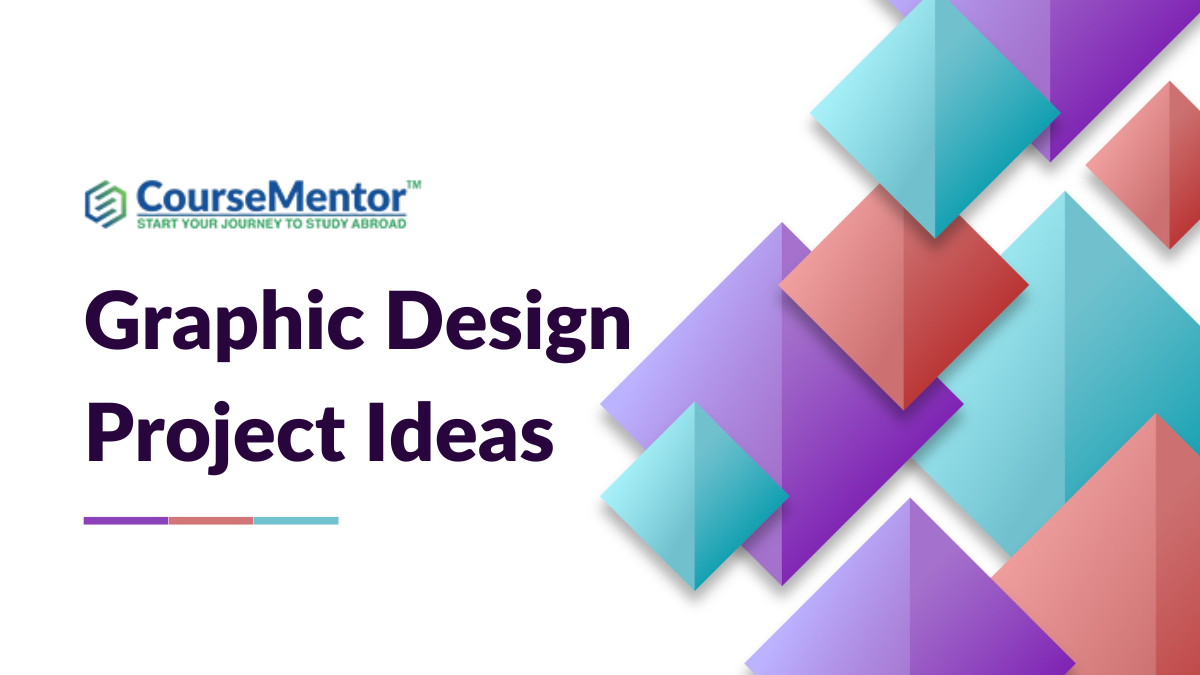In the dynamic world of graphic design, creativity knows no bounds. Every project is an opportunity to experiment, innovate, and leave a lasting impression. Whether you’re a seasoned designer seeking fresh inspiration or a budding creative looking to embark on your design journey, the realm of graphic design projects offers endless possibilities. This blog will cover a wide range of graphic design project ideas, including project kinds, factors to take into account for a successful completion, current concepts, difficulties faced by designers, and advice for a successful design expedition.
Importance of Graphic Design Projects
Graphic design projects serve as the cornerstone of effective communication in a visually-driven world. Their importance transcends mere aesthetics, playing a pivotal role in conveying messages, shaping perceptions, and building memorable brand identities. Here are some key points highlighting the significance of graphic design projects:
- Visual Communication: Graphic design projects act as powerful mediums for conveying complex ideas and messages in a concise and visually appealing manner. Through the strategic use of typography, imagery, colour, and layout, designers can captivate audiences and evoke desired emotions.
- Brand Identity: Consistent and well-executed graphic design projects are instrumental in establishing and reinforcing brand identities. Logos, colour schemes, and brand collateral communicate a brand’s values, personality, and positioning, fostering recognition and loyalty among consumers.
- Engagement and Impact: Creatively crafted graphic design projects have the ability to capture attention, engage audiences, and leave a lasting impression. Whether through eye-catching posters, compelling advertisements, or interactive digital experiences, design projects have the power to spark curiosity and drive action.
- User Experience (UX): In the digital realm, graphic design projects play a crucial role in shaping user experiences. Intuitive interfaces, clear navigation, and visually appealing layouts enhance usability and ensure a seamless interaction between users and digital platforms, fostering positive user experiences.
- Information Visualisation: Graphic design projects, such as infographics and data visualisations, transform complex data and information into visually digestible formats. By presenting information in a visually engaging and accessible manner, designers facilitate understanding, decision-making, and knowledge dissemination.
- Innovation and Creativity: Graphic design projects provide fertile ground for experimentation, innovation, and creative expression. Designers constantly push boundaries, exploring new techniques, technologies, and trends to deliver fresh and impactful design solutions.
- Cultural and Social Influence: Graphic design projects reflect and shape cultural trends, societal norms, and collective values. From political posters to social media campaigns, design projects have the power to spark conversations, challenge perspectives, and drive social change.
In essence, graphic design projects serve as catalysts for effective communication, brand differentiation, user engagement, and cultural influence. Their importance lies not only in their visual appeal but also in their ability to inform, inspire, and connect with audiences on a profound level.
51+ Graphic Design Project Ideas
- Logo design for a new startup.
- Poster design for an upcoming event or concert.
- Business card design for a freelancer or small business owner.
- Flyer design for a local business promotion.
- Brochure design for a tourism company or travel destination.
- Social media graphics for a marketing campaign.
- Website design for a portfolio or personal blog.
- Email newsletter design for a company’s monthly updates.
- App interface design for a mobile application.
- Digital advertisements for an online marketing campaign.
- Magazine layout design for a niche publication.
- Book cover design for a new novel or non-fiction book.
- Packaging design for a new product launch.
- Invitation design for a wedding or special event.
- T-shirt design for a clothing brand or event merchandise.
- Branding guidelines development for a new company or rebranding initiative.
- Brand collateral design (letterheads, envelopes, etc.) for a corporate identity.
- Brand refresh design to modernize an existing brand identity.
- Brand style guide design to ensure consistency across all brand materials.
- Branding campaign design for a product or service launch.
- Digital illustrations for an editorial publication or marketing campaign.
- Hand-drawn illustrations for a children’s book or greeting cards.
- Infographic design to visualize complex data or information.
- Typography art for a motivational poster or inspirational quote.
- Artistic collage design for a mixed media project or social media post.
- Intro/outro animation for YouTube videos or online content.
- Explainer video animation for a product demonstration or tutorial.
- Animated GIFs for social media engagement or marketing.
- Motion graphics for presentations or video content.
- Character animation for cartoons, advertisements, or branding.
- Signage design for a retail store or event venue.
- Exhibition booth design for a trade show or industry event.
- Environmental graphics for interior design or corporate spaces.
- Wayfinding design for a campus or large facility.
- Retail store design elements for a store layout or display.
- Interactive infographics for online articles or reports.
- Interactive website features for user engagement and interactivity.
- Augmented reality (AR) filters for social media platforms.
- Interactive product demos for e-commerce websites.
- Gamification elements for educational or marketing purposes.
- Virtual reality (VR) interfaces for immersive experiences.
- Voice user interface (VUI) design for smart devices or applications.
- Data visualisation projects for statistical analysis or research findings.
- Experimental typography projects for artistic expression.
- Collaborative design projects with artificial intelligence (AI) tools.
- Social media profile branding for individuals or businesses.
- Album cover design for musicians or bands.
- Restaurant menu design for a dining establishment.
- Icon design for mobile apps or website interfaces.
- Event program design for conferences or festivals.
- Car wrap design for a promotional vehicle.
- Environmental activism campaign materials for nonprofits or advocacy groups.
- 3D modelling and rendering for product visualisation or architectural projects.
Emerging Trends and Experimental Projects
Augmented Reality (AR) Integration
Graphic designers are increasingly exploring the integration of augmented reality (AR) into their projects. By overlaying digital content onto the physical world, AR enhances user experiences and creates interactive storytelling opportunities. Experimental projects in AR include AR-enabled packaging, interactive print advertisements, and AR-powered art installations that merge digital and physical realms.
NFT Art and Digital Collectibles
Non-fungible tokens (NFTs) have revolutionised the way digital art is bought, sold, and experienced. Graphic designers are experimenting with creating NFT art and digital collectibles, exploring new avenues for monetizing their work and engaging with audiences in the digital space. These projects often incorporate unique visual styles, interactive elements, and blockchain technology to create one-of-a-kind digital assets.
Generative Design and Computational Art
Generative design and computational art leverage algorithms and code to create dynamic, evolving visual compositions. Graphic designers are delving into generative design techniques to produce artwork, animations, and graphics that respond to user input or real-time data. These experimental projects blur the line between design and programming, resulting in visually captivating and conceptually rich experiences.
Biodesign and Living Materials
With a growing emphasis on sustainability and biomimicry, graphic designers are exploring biodesign and the use of living materials in their projects. Experimental initiatives involve creating graphics, packaging, and installations using biodegradable or living materials such as mycelium, algae, and bacteria. These projects highlight the potential of design to address environmental challenges and foster a deeper connection with nature.
Emotional Design and Neuroaesthetics
Graphic designers are delving into the realm of emotional design and neuroaesthetics, exploring how visual elements can evoke specific emotions and influence user perceptions. Experimental projects focus on incorporating psychological principles and sensory stimuli into design, creating experiences that resonate on a deeper emotional level. These projects often employ color psychology, typography techniques, and visual metaphors to evoke specific emotional responses from audiences.
Experimental Typography and Variable Fonts
Typography remains a rich area for experimentation and innovation in graphic design. Designers are pushing the boundaries of typographic expression through experimental typography projects that explore unconventional letterforms, kinetic typography, and variable fonts. These projects challenge traditional typographic conventions and offer new avenues for self-expression and creativity in design.
AI-Driven Design Tools and Automation
The rise of artificial intelligence (AI) is transforming the graphic design landscape, enabling designers to automate repetitive tasks and streamline their workflows. Experimental projects involve leveraging AI-driven design tools for tasks such as image generation, layout optimization, and content creation. These projects explore the potential of AI to augment human creativity and expand the possibilities of graphic design practice.
Factors affecting graphic design project ideas
Client Needs and Objectives
Understanding the needs, goals, and preferences of clients is paramount in generating effective graphic design project ideas. Factors such as the client’s industry, target audience, brand identity, and marketing objectives shape the direction and scope of design projects. Designers must conduct thorough client consultations to gather insights and establish clear project requirements before conceptualising design ideas.
Audience Demographics and Preferences
Consideration of the target audience’s demographics, preferences, and behaviour patterns is crucial in generating graphic design project ideas that resonate with end-users. Designers must conduct audience research to gain a deep understanding of their preferences, aesthetic sensibilities, and communication preferences. Design ideas should be tailored to align with the audience’s interests, values, and cultural backgrounds to maximise engagement and impact.
Design Trends and Innovations
Keeping abreast of current design trends, emerging technologies, and innovative techniques is essential for generating fresh and relevant graphic design project ideas. Designers draw inspiration from trends in typography
Project Constraints and Parameters
Graphic design projects are often subject to various constraints and parameters, including budgetary limitations, time constraints, technical specifications, and platform requirements. Designers must factor in these constraints when generating project ideas to ensure feasibility and practicality. Creativity thrives within constraints, and designers can leverage limitations as opportunities to innovate and problem-solve creatively.
Personal Creativity and Design Vision
Ultimately, the designer’s creativity, vision, and artistic sensibilities play a central role in generating compelling graphic design project ideas. Designers draw upon their unique perspectives, experiences, and creative instincts to conceptualise design concepts that captivate and inspire. Embracing experimentation, risk-taking, and self-expression allows designers to push boundaries, challenge conventions, and create truly original and impactful design solutions.
Conclusion
In summary, this revised compilation of 51+ graphic design project ideas serves as a rich resource for designers at every stage of their creative journey. From traditional print projects to cutting-edge experiments in emerging technologies, each idea presents an opportunity for exploration, innovation, and expression. By embracing these diverse avenues of design, designers can push the boundaries of their craft, captivate audiences, and leave a lasting impact on the ever-evolving landscape of graphic design. Let this comprehensive list inspire your next project and propel you towards new heights of creativity and success in the dynamic world of design.





